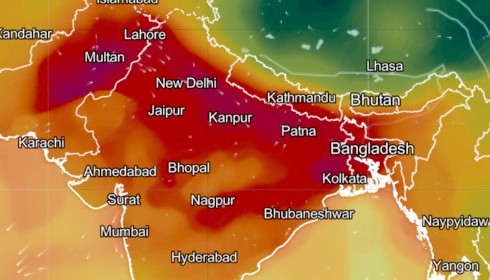
PM2.5 Exposure Harms Children's Learning, Memory: USC Study
A new study from the University of Southern California (USC) showed worrying findings on how particular air pollutants are impairing children's learning and memory capacities. This peer-reviewed study, which included 8,500 youngsters from across the United States, focuses on the neurocognitive impairment caused by tiny particulate matter (PM2.5), particularly a component known as ammonium nitrate. These findings highlight the potential repercussions for Indian children, particularly in cities with high PM2.5 levels caused mostly by agricultural practices and traffic pollution.
The USC study, published in Environmental Health Perspectives, reveals that exposure to PM2.5—tiny particles smaller than 2.5 micrometres in diameter—may impair children's memory and learning ability. Researchers have identified ammonium nitrate, a byproduct of agricultural pollutants and fossil fuel burning, as a major contributor to cognitive impairment. "Our study highlights the need for more detailed research on particulate matter sources and chemical components," stated Dr. Megan Herting, the study's principal author and an associate professor at USC. "It suggests that understanding these nuances is crucial for informing air quality regulations and understanding long-term neurocognitive effects."
Dr. Herting's prior research on PM2.5 demonstrated its relevance in respiratory and cardiovascular disorders; however, this study goes deeper into the neurocognitive effects. The current study, revealing a connection between ammonium nitrate particles and cognitive impairment, raises significant concerns, especially for Indian children exposed to high levels of these pollutants.
In 2023, PM2.5 composition across major Indian cities varies significantly due to diverse pollution sources, including industrial activities, vehicle emissions, and agricultural practices. Data from the Central Pollution Control Board (CPCB) and the Indian Institute of Tropical Meteorology (IITM) highlights the predominant contributors to PM2.5 in Delhi, Mumbai, Kolkata, and Bengaluru.
Delhi’s PM2.5 primarily consists of 38.2% organic carbon (OC), 16.3% elemental carbon (EC), 14.9% nitrate (NO₃⁻), and 7.2% ammonium (NH₄⁺), indicating a strong influence from vehicular and industrial sources. In Mumbai, the mix includes 29.4% OC, 12.1% EC, 10.9% NO₃⁻, and 8.9% NH₄⁺, driven by traffic and coastal factors. Kolkata’s air shows 33.5% OC, 14.9% EC, 12.1% nitrate, and 8.1% ammonium, largely due to industrial emissions and biomass burning. Bengaluru’s PM2.5 profile is comprised of 28.9% OC, 11.4% EC, 9.5% NO₃⁻, and 8.5% NH₄⁺, reflecting emissions from urban transportation and local industries.
This breakdown demonstrates the dominance of organic and elemental carbon in Delhi, as well as considerable levels of ammonium nitrate in other major cities. According to the USC study's findings, excessive ammonium levels in cities such as Mumbai and Bengaluru may have a direct impact on children's cognitive health.
People widely view the effects of PM2.5 on cognition as a pressing issue, especially in underdeveloped nations where children are more susceptible to environmental stressors. "The cognitive impacts we are witnessing in children may very well result in a lifelong disadvantage," said Dr. Sunita Narain, Director of India's Centre for Science and Environment. "Reducing these pollutants isn't just about improving air quality; it's about safeguarding the mental and cognitive development of future generations."
Particulate matter in India varies significantly by season. For example, increased concentrations of organic carbon, elemental carbon, and nitrate are detected in winter as a result of biomass burning, which contributes considerably to respiratory ailments and probable cognitive impairment.
The USC study emphasises the critical need for targeted air quality rules that target specific pollution sources, particularly those that damage cognition. Dr. Herting's team employed advanced statistical techniques to identify 15 chemical components in PM2.5 and assess their individual effects. No matter how we examined it, on its own or with other pollutants, they found the most robust link between ammonium nitrate particles and poorer learning and memory.
India's air pollution policies have traditionally focused on overall air quality requirements, but they may need to shift toward stronger limits on individual pollutants such as ammonium nitrate. Furthermore, actions such as limiting agricultural burning, regulating vehicle emissions, and encouraging cleaner industrial practices might greatly reduce exposure to these dangerous particles.
Along with policy changes, public awareness and community action are essential. Schools and community centers can play an important role by installing interior air purification systems and fostering "green" spaces in urban settings. Parents can help by monitoring air quality and restricting outside activity on high-pollution days.
Researchers, including Dr. Herting and her colleagues, are currently working to map the effects of various pollutant combinations on the brain. "Our goal is to understand how these mixtures affect individual differences in brain phenotypes during child and adolescent development," she told me.
The USC study, when combined with data from Indian cities, demonstrates the critical need for focused actions to reduce PM2.5 and its damaging components. With children's cognitive capacities under threat, India must prioritize regulatory improvements and public health activities. As Dr. Herting puts it, "Addressing the composition of pollutants, not just the overall PM2.5 levels, is essential to protect not only children's health today but also their future potential."